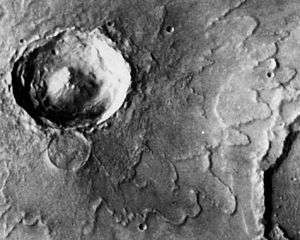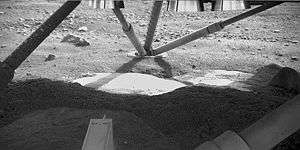Rampart crater

Rampart craters are a specific type of Martian impact crater which are accompanied by distinctive fluidized ejecta features. A Martian Rampart crater displays an ejecta with a low ridge along its edge. Usually, rampart craters show a lobate outer margin, as if material moved along the surface, rather than flying up and down in a ballistic trajectory. The flows sometimes are diverted around small obstacles, instead of falling on them. The ejecta look as if they move as a mudflow. Some of the shapes of Rampart craters can be duplicated by shooting projectiles into mud. Although rampart craters can be found all over Mars, the smaller ones are only found in the high latitudes where ice is predicted to be close to the surface. It seems that the impact has to be powerful enough to penetrate to the level of the subsurface ice. Since ice is thought to be close to the surface in latitudes far from the equator, it does not take too strong of an impact to reach the ice level.[1] So, based on images from the Viking program in the 1970s, it is generally accepted that rampart craters are evidence of ice or liquid water beneath the surface of Mars. The impact melts or boils the water in the subsurface producing a distinctive pattern of material surrounding the crater.
The Phoenix lander confirmed the existence of large amounts of water ice in the northern regions of Mars. This finding was predicted by theory and was measured from orbit by the Mars Odyssey instruments, so the idea that rampart crater size shows the depth to ice was confirmed by other space probes. The image below from the Phoenix lander shows ice that was exposed by the descent engines.
They are normally small craters found in the far north or south parts of the planet
 View underneath Phoenix lander towards south foot pad, showing patchy exposures of a bright surface that was later confirmed to be water ice, as predicted by theory and detected by Mars Odyssey.
View underneath Phoenix lander towards south foot pad, showing patchy exposures of a bright surface that was later confirmed to be water ice, as predicted by theory and detected by Mars Odyssey.
References
| Wikimedia Commons has media related to Rampart craters. |
- The Role of Subsurface Ice in Rampart Crater Formation
- Viking 1 orbiter image, 1977
- Ages and Onset Diameters of Rampart Craters In Equatorial Regions on Mars.
- Craters as seen by Viking